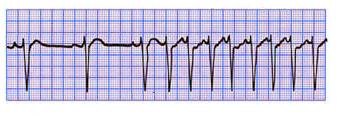Medicine: CVS Exam Quiz!

- 1.
All of the following drugs reduce the ventricular rate in atrial fibrillation, except:
- A.
Procainamide
- B.
Verapamil
- C.
Digoxin
- D.
Propranolol
- E.
Dialtiazem
Correct Answer
A. ProcainamideExplanation
Kumar page 775, and Dr.Akhtar lectureRate this question:
-
- 2.
Regarding the previous EEG, what's the proper/best treatment:
- A.
CD shock
- B.
Digoxin
- C.
Amiodarone
Correct Answer
C. AmiodaroneExplanation
Amiodarone is the proper/best treatment for the previous EEG. Amiodarone is an antiarrhythmic medication that is commonly used to treat irregular heart rhythms, including ventricular fibrillation and ventricular tachycardia. It works by slowing down the electrical signals in the heart, helping to restore a normal heart rhythm. This medication is often preferred over other options like CD shock or digoxin due to its effectiveness and safety profile.Rate this question:
-
- 3.
All of the following are true about Lidocaine except:
- A.
Half life is hours
- B.
Metabolized in liver
- C.
Effective in ventricular arrhythmia
Correct Answer
A. Half life is hoursExplanation
Reference:
Dr. Akhtar lecture (antiarrhythmia) - 6th year.
The elimination half-life of lidocaine is approximately 1.5–2 hours in most patients.
Lidocaine undergoes extensive first pass metabolism in the liver.
it is used for the acute management of ventricular arrythmias, especially in patients with myocardial infarctionRate this question:
-
- 4.
Regarding paroxysmal supraventricular tachycardia (SVT), which is TRUE:
- A.
Common in acute MI
- B.
Ventricular rate = atrial rate
- C.
Atrial rate 300 bpm, ventricular 150 bpm
- D.
DOC is amiodarone
- E.
Digoxin IV reduces paroxysmal SVT rate
Correct Answer
E. Digoxin IV reduces paroxysmal SVT rateExplanation
( Harrison’s principles of internal medicine , 16th edition , table 214-4 , p.1348 )Rate this question:
-
- 5.
All of the following will show ventricular rate in atrial fibrillation, EXCEPT:
- A.
Disopyramide
- B.
Amiodarone
- C.
Diltiazem
- D.
Verapamil
- E.
Tremolol
Correct Answer
A. DisopyramideExplanation
Answer is: a, according to Dr. A5tar lecture: one of the side effects of class I (quinidine and Disopyramide) is ventricular tachycardia, which is a life-threatening condition. As A. fib is not a life-threatening condition and the quinidine has this serious side effect, it should be avoided. However, if you are willing to give quinidine, give another drug which reduces HR such as CCB or digoxin.Rate this question:
-
- 6.
Severe Aortic stenosis criteria:
- A.
Loud S1
- B.
Loud murmur
- C.
None of the above
Correct Answer
C. None of the aboveExplanation
this was an incomplete question, the right answer wasn't remembered
from dr Akhtar's lectures..
AS is considered to be severe when:
1. AVOA < 0.8 cm2,
2. Systolic Pressure Gradient Across AV > 50 mmHg
Symptoms in severe cases:
- Low CO symptoms (Syncope)
- Angina
- CHF
- SCD = Sudden cardiac deathRate this question:
-
- 7.
All of the following are a feature of tricuspid regurgitation except:
- A.
Prominence a wave
- B.
Pulsatile liver
- C.
Left parasternal heave
- D.
Pan-systolic murmur
- E.
Right atrial enlargement
Correct Answer
A. Prominence a waveExplanation
In TR a wave is not prominant, v wave is the one that will be prominantRate this question:
-
- 8.
Angina pectoris + syncope, can be symptoms of which of the following:
- A.
MS
- B.
MR
- C.
TR
- D.
AR
- E.
AS
Correct Answer
E. ASExplanation
In severe cases of AS, a patient can present with both angina pectoris and syncope
Reference: Dr. Akhtar's lecture VHDRate this question:
-
- 9.
All are found in chronic mitral regurgitation ,except:
- A.
S3 gallop
- B.
s4 gallop
- C.
Left atrial enlargement
- D.
Left ventricular enlargement
- E.
Heave apical pulse
Correct Answer
B. s4 gallopExplanation
In chronic MR both left ventricle & left atrium are enlarged. (Davidson 622)
Apex beat is heaving due to left ventricular dilatation. A loud third heart sound (S3) may be present due to sudden rush of blood back into the dilated left ventricle in early diastole (Danish 102)
An S4 gallop is uncommon in chronic mitral regurgitation. However, in acute mitral regurgitation, an S4 gallop is common because the left atrium and ventricle are noncompliant.
So, the most likely answer is S4 gallopRate this question:
-
- 10.
Case: A patient with mitral regurgitation, exercise intolerance, and his left ventricular end-diastolic diameter (LVEDD) is 6.8 cm, how do you manage him?
- A.
Do mitral valve replacement
- B.
Check & follow up every year
- C.
Medical treatment
Correct Answer
A. Do mitral valve replacementExplanation
Reference:
Cardiology Pocket Book.
Comment:
Surgery is indicated here due to progressive symptoms and valvular damage (normal ventricular end diastolic diameter is 3.5-5.6).Rate this question:
-
- 11.
Regarding mitral valve prolapse all are true except:
- A.
Mid systolic click.
- B.
Pansystolic murmuer.
- C.
Late systolic murmur.
- D.
Atypical chest pain.
- E.
Concentric left ventricular Hypertrophy.
Correct Answer
C. Late systolic murmur.Explanation
In MVP there is mid diastolic click in mild cases and pansystolic murmur if significant mitral regurgitation. The click is believed to be produced by sudden tensing of elongated chordae tendineae of prolapsing leaflets
Most patients are asymptomatic. In symptomatic patient it presents as chest pain (atypical), dyspnea, palpitation, syncope and sudden death. chest pain is similar to angina but may last for hours or for days, not related to exertion, and punctuated by brief attacks of severe stabbing pain at the apex.
Reference: Danish 103-104Rate this question:
-
Quiz Review Timeline +
Our quizzes are rigorously reviewed, monitored and continuously updated by our expert board to maintain accuracy, relevance, and timeliness.
-
Current Version
-
Mar 20, 2023Quiz Edited by
ProProfs Editorial Team -
Aug 29, 2009Quiz Created by
Amani86
 Back to top
Back to top


